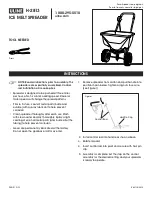
LOWLANDER MK4 MANURE SPREADER – INSTRUCTION & SPARES MANUAL
Page
79
Test 3 (Smooth Operation/No Residual Pressure)
Swap the test coupling to the yellow line or attach the gauge and test hose to any test point in the yellow line leading
up to port 4 of the RELSV.
Attach the other gauge to a test point on any brake chamber. If none are available, then an M16x1.5 threaded one can
be added to a brake chamber, as most brake chambers have an extra port which has been blanked.
Fully charge the trailer and keep the red susie connected.
Place the two gauges close together and monitor them both as the service brakes are slowly and repeatedly applied
on and off.
Both pressures should be seen to rise and fall smoothly, with both showing zero bar when the tractor’s brakes are
released. (Do not worry if the pressure at the brake chamber is lower than that of the yellow line, as we are not yet
testing the settings of the RELSV.) If the pressure in the yellow line is “jerky”, then so will be the pressure in the brake
chamber. This would indicate a problem with the tractor’s brakes, in particular with its trailer control valve.
If the yellow line pressure is smooth, but jerky at the brake chamber, then the problem is trailer related, and this is
found by moving the gauge from the brake chamber to the output of the RELSV (port 2). The test can be repeated, and
if the pressure still is not smooth then this indicates a faulty RELSV. If it was smooth, then the problem is inside the
ABS modulator, as it must be giving out a jerky pressure, even though it is signalled with a smooth one.
The same tests can be repeated for looking for residual pressure problems, should both gauges not show zero
pressure when the service brakes are released.
Test 4 (Output of the RELSV)
The RELSV is connected between the chassis and axles, and senses the way the springs deflect, as increasing weight
causes them to flatten. This movement is transferred to the RELSV operating arm via a vertical linkage. This linkage,
along with any other components (angle iron, cotton reels etc) should be periodically checked for signs of damage or
becoming loose.
In order to check that the RELSV is functioning correctly, the linkage can be removed from the operating arm, and the
service brakes applied. The red susie needs to be connected for this test. An air gauge in the brake chamber will show
the output pressure, and this gauge can be observed whilst the operating arm is rotated. As the operating arm is
raised the brake chamber pressure should increase until it matches the service line pressure and decrease as the arm
is lowered. This demonstrates that the load sensing function of the RELSV is working.
When the vertical linkage is reattached to the operating arm, it is important
that the arm is at the correct angle to give the proper braking pressure for the
weight being carried.
A decal is fitted to the arm, which rotates with the arm passing a pointer on
the RELSV’s casting. This decal shows the approximate setting for the RELSV,
but the valve is best set when the trailer is empty, and the linkage adjusted
until the correct unladen pressure is given, when a known “test pressure” is
used.
A typical unladen decal position is shown to the left, but this is only shown for
a guide.
The trailer builder should be able to provide this information, if it does not
appear on a LSV data plate attached to the chassis.
Full RELSV setting instructions are given on the next two pages.
Содержание Lowlander MK4
Страница 2: ......
Страница 4: ......
Страница 6: ......
Страница 29: ...LOWLANDER MK4 MANURE SPREADER INSTRUCTION SPARES MANUAL Page 24 Type C Junction Box ...
Страница 132: ...LOWLANDER MK4 MANURE SPREADER INSTRUCTION SPARES MANUAL Page 127 12 NOTES ...
Страница 137: ......
















































